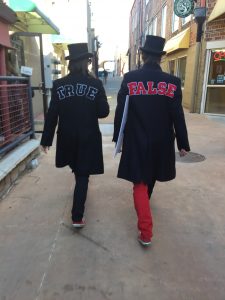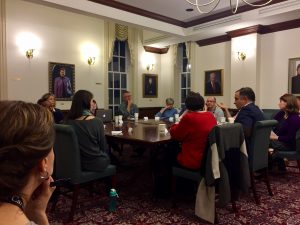I am no stranger to Southern charm. My grandmother (a.k.a. Mammaw) is one of the sassiest Southern ladies I know, which makes her a compelling character any time she steps outside the South. When restaurant-goers hear her ask for a sweet tea in a strong Carolina accent, they are immediately intrigued, and I end up being her translator.
That same type of charm stood out to me when I watched Lindy Lou, Juror Number 2, a new documentary about a lady from Mississippi who served on a U.S. death penalty trial 20 years ago. The story follows Lindy Lou’s journey across Mississippi to find the 11 other jurors on her trial, and it captures her candid conversations about the emotional impact of the decision. Although Lindy initially had no remorse when she sentenced a man to death, she began to question the morality of her decision after she cultivated a friendship with him on death row. Lindy – as director Florent Vassault notes – is not your typical anti-death penalty liberal. She’s a gun-toting, tell-it-like-it-is Mississippi grandma with undeniable charisma.
The Center for Media & Social Impact (CMSI), where I am a graduate fellow, collaborated with BRITDOC, a powerhouse UK- and NY-based nonprofit dedicated to supporting social issue documentaries, to learn more how Lindy Lou’s story could affect people’s perceptions of the death penalty and to help develop a social-impact strategy. To find out, fellow CMSI graduate fellow and researcher Michele Alexander and I ventured to Columbia, Missouri, for the film’s premiere at the True/False Film Festival.
Doc Fans in the Midwest?
Prior to arriving to Missouri for the festival, my only knowledge of the state was its high occurrence of tornadoes in the spring. While this is true (and thankfully did not happen while we were there), I was surprised to learn that the city of Columbia becomes quite the hub for documentary enthusiasts every March. The whole town teems with energy from the True/False Film Festival, which is one of the top festivals in the world that explores the intersection of documentary and investigative journalism. People wore True/False attire (see photo), every restaurant had a special menu for the occasion, and there were even quirky parades down Main Street in honor of the festival.

Soon after Michele and I acclimated to the Midwestern hipster vibes of True/False and got to know our British collaborators, we dove into the research. To capture immediate audience reactions to the film and to understand their perspectives about the death penalty more broadly, CMSI and BRITDOC facilitated customized audience surveys and a local focus group at the festival.
Initial Insights
Now I won’t bore you with the nitty gritty of the data, but Michele and I noticed interesting patterns from our initial findings fairly quickly. In the focus group, all respondents seemed to agree that while the film brought new perspective to the death penalty, this added layer of complexity did not change their opinion on capital punishment per se. This matches the general complexity of the issue, as we learned from existing public opinion data. In the surveys that viewers took before and after screenings, we saw similar trends. Of the responses we collected by Saturday, most did not appear to emerge as anti-death penalty advocates ready to take action; however, they did indicate that they now recognized the emotional toll it takes on jurors. And this, of course, matched the quiet treatment of the issue in the film itself, which we anticipated could be strategically useful because it encourages individual moral reflection, rather than projecting an assertive stance.
And guess what else we found?

Lindy Lou at a Q&A
Virtually all viewers liked Lindy. More specifically, over 80 percent of them “agreed” that they liked her, so I may go out on a limb here and say they loved her. That is the Southern charm in action, I believe. According to our initial survey findings, many found her credible, believable and informative – which is notable, considering she is not an “expert” on the death penalty. The admiration was evident when she revealed herself at the Q&A sessions after the screenings. Audiences stood up, cheered and could not wait to hear from Lindy. I heard whispers behind me, “Oh my gosh, she’s here!”
It was an exciting experience for Lindy as well, because True/False was the first time she had seen Florent’s completed film. When asked how she felt about the final product, she joked that she told Florent she would pinch him if there was anything she did not like. The verdict? “I didn’t pinch him one time,” she said with an honest smile during a Q&A.
The Strategy Summit
Of course, we did not gather all these interesting responses and then call it a week. By Saturday, it was time to put these research findings into action. Our sharp and constantly traveling research director/professor, CMSI’s director, Caty Borum Chattoo, arrived Saturday from a conference in Florida to glean key insights for the strategy summit that afternoon. This involved putting together graphs, notes and a PowerPoint in a very professional manner – that is, in the hotel lobby in less than two hours. Before we toted our research into town, we all agreed to grab chicken finger plates at Zaxby’s (I forced them to go). This may seem tangential to my blog, but I promise it’s not. Zaxby’s is this amazing chicken restaurant I thought only graced the South, so I was shocked and delighted to see it in Columbia, Missouri. Like Lindy’s charm, it was another unexpected Southern connection made on this research adventure – see, it ties in! (Full disclosure: I am not being paid by Zaxby’s, just passionate.)

Documentation of the Zaxby’s experience.
Anyway, after we ate the incredibly delicious meal that my soul needed, it was time for the finale of our trip: the strategy summit meeting. Professor Chattoo presented our survey and focus group findings to a group of community, academic and faith leaders in Missouri already working on death penalty issues. Our research and strategy counsel helped these leaders and advocates devise approaches for using the documentary as a method for issue education and policy change. For example, a minister in attendance suggested a screening for his congregation as a way to promote discussion on the morality of capital punishment. In addition, a law professor at the meeting mentioned how College Democrats and Republicans at the University of Missouri could use the film to find common ground on the issue.

The strategy summit meeting.
My personal favorite reaction was from Lindy Lou herself, who was also present at the table. She was astounded that people wanted to use her story – just a grandmother from Mississippi – as a tool for advocacy. At the conclusion of the meeting, Lindy told everyone there she honestly never thought her journey as a juror would take her this far. She thought the only change she could initiate would be through conversations with her grandkids. Now she sees herself and her story as a pebble sending out ripples of greater change – a metaphor she referenced in the film and throughout the festival.
Lindy Lou’s pebble metaphor is also what stuck with me. The biggest takeaway from my True/False research experience is acknowledging the power of a compelling character’s authentic story. Engaging audiences with a complex and nuanced subject like the death penalty is no easy task; and I don’t think anyone thought a sassy Southern grandma could accomplish such a feat. However, Lindy’s charm is indeed the pebble. She demonstrates how a single, unexpected story may cause the first ripples toward a new tide of social change.

